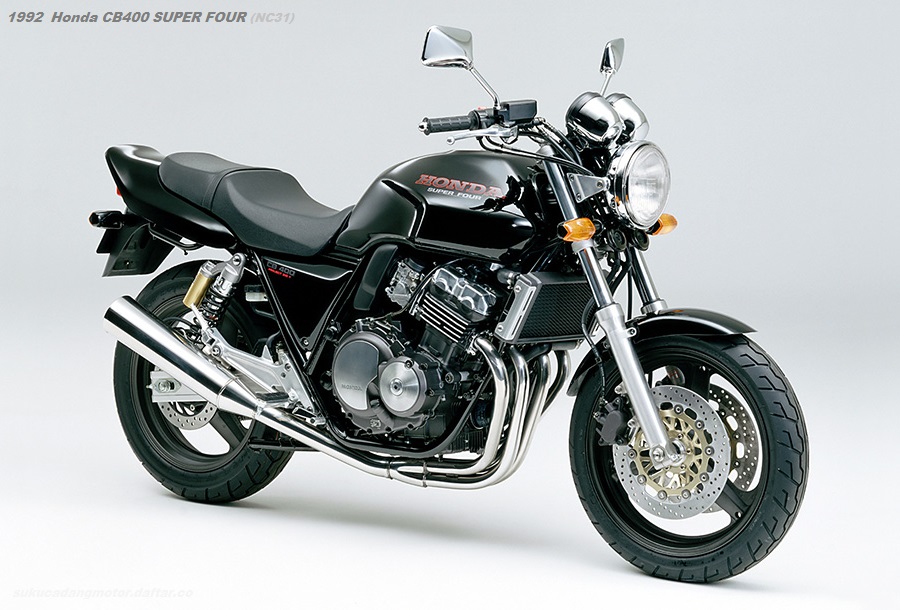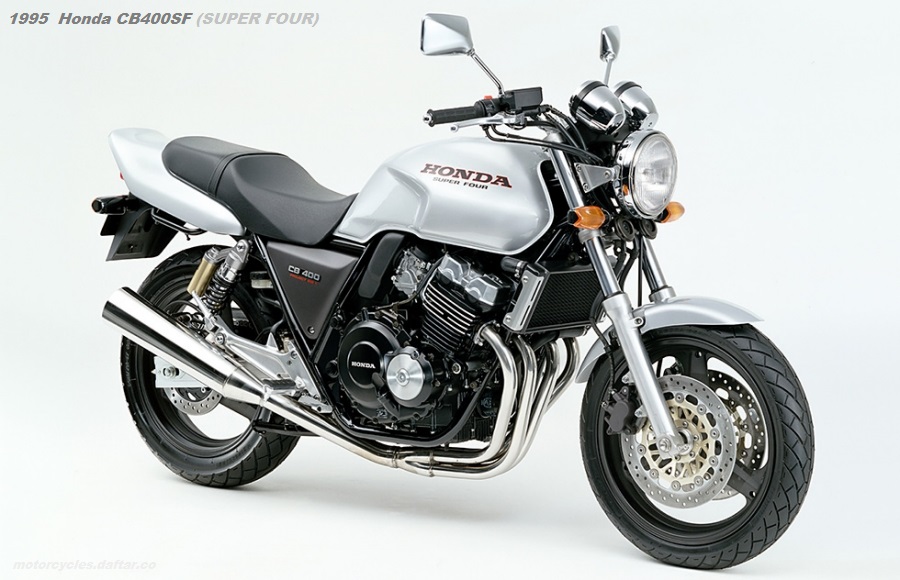1992-1998 Honda CB400 SUPER FOUR (NC31) Carburetor Specs, Price, Overview & Photos Gallery
 |
| 1992 Honda CB400SF SUPER FOUR picture. A naked road sports bike that combines elegant form and excellent usability. Release date: 1992-04-23 |
This Honda CB400 SUPER FOUR is a 400cc version of the “CB1000 SUPER FOUR”, which was a reference model at the 29th Tokyo Motor Show last year and was very well received. It is a model that has been developed so that it can be ridden with a medium-sized motorcycle license, thoroughly pursuing “should it be”.
The CB400SF engine is equipped with a water-cooled, 4-cycle, DOHC, in-line 4-cylinder, 399cc engine. It realizes a powerful and exhilarating running taste even in the necessary high rotation range.
In addition, cooling fins are provided on the side of the cylinder, and the entire engine is painted in a rugged matte gray metallic paint, with a luxurious buffed engine head cover and a megaphone-type all-stainless steel muffler. Combined with this, it is powerful and powerful.
For the frame and undercarriage, a double cradle frame with round cross-section pipes is used to provide a smooth ride in a wider range of driving conditions. The front suspension employs a damper structure that exhibits smooth damping force characteristics, while the rear suspension is equipped with a reservoir tank damper with excellent heat dissipation that exhibits stable damping force characteristics even during hard driving. Combined with the long wheelbase (1,455mm), it achieves both a comfortable ride and excellent driving performance.
In addition, a utility box with a capacity of 5.5L that can store small items for daily use is installed under the seat, which emphasizes a comfortable length and fit even when two people are riding. Both of them are equipped with luggage hooks on the left and right 4 points, which are useful for touring, etc., making them easy to use.
In addition, a center stand is standard equipment, and consideration is given to daily maintenance. The brakes are equipped with a hydraulic double disc on the front and a hydraulic single disc on the rear, with tubeless tires (front: 110/70-1754H, rear: 140/70-). 17 66H) and a combination of lightweight 3-spoke aluminum wheels reduces unsprung weight and realizes a light driving feel.
The design expresses a clean appearance, such as a powerful and voluminous large-capacity (18L) fuel tank shape composed of smooth curves and surfaces, an independent side cover, and a rear cowl with a feeling of dynamism. At the same time, it has a unique form that is fearless and powerful. In addition, he has set a total of 5 colors, a simple solid color (3 colors) and a chic two-tone color (2 colors), to expand the range of choices.
Honda CB400SF makes use of the smooth and powerful output characteristics of the in-line 4-cylinder engine, and enjoys the straightforward driving taste from city driving to winding roads outside the city, and has a powerful and unique form and function. The solid color of the naked road sports bike “Honda CB400 SUPER FOUR” that fuses the style was released on April 23rd 1992, and the two-tone color was released on June 10th 1992.
Honda CB400 SUPER FOUR 1992-04-23
Honda CB400SF Main specifications
| Nickname | CB400 SUPER FOUR | |
| Model | NC31 | |
| Length×Width×Height (m) | 2.085×0.735×1.080 | |
| Length (m) | 1.455 | |
| Minimum ground clearance (m) | 0.125 | |
| Seat height (m) | 0.770 | |
| Vehicle weight/dry weight (kg) | 192/172 | |
| Capacity (person) | 2 | |
| Fuel consumption rate (km/l) 60km/h level running test value | 34.7 | |
| Minimum turning radius (m) | 2.6 | |
| Engine model | NC23E (water-cooled, 4-cycle, DOHC, 4-valve, 4-cylinder) | |
| Total Displacement (cm3 ) | 399 | |
| Inner Diameter x Stroke (mm) | 55.0×42.0 | |
| Compression Ratio | 11.3 | |
| Max output (PS/rpm) | 53/11,000 | |
| Max torque (kgm/rpm) | 3.7/10,000 | |
| Carburetor model | VP22 | |
| Starting method | Self-operated | |
| Ignition type | Full transistor battery ignition | |
| Lubrication method | Combined pumping and splashing method | |
| Lubricant capacity (L) | 3.6 | |
| Fuel tank capacity (L) | 18 | |
| Clutch type | Wet multi-plate coil spring | |
| Transmission type | Constant mesh 6-speed return | |
| Transmission ratio | 1st gear | 3.307 |
| 2 speed | 2.294 | |
| 3 speed | 1.750 | |
| 4 speed | 1.428 | |
| 5 speed | 1.240 | |
| 6 speed | 1.130 | |
| Reduction ratio (primary/secondary) | 2.171/2.800 | |
| Caster (deg)/Trail (mm) | 27°15′/109 | |
| Tire size | Front | 110/70-17 54H |
| Rear | 140/70-17 66H | |
| Brake type | Front | Hydraulic disc |
| Rear | Hydraulic disc | |
| Suspension method | Front | Telescopic method |
| Rear | Swing arm type | |
| Frame Format | Double Cradle | |
Manufacturer’s suggested retail price of Honda CB400SF in 1992
- Solid Color : 589,000 yen
- Two-tone color : 599,000 yen
(Hokkaido and Okinawa prices are 9,000 yen higher, excluding some remote islands.)
(Vehicles equipped with speed warning lights are 10,000 yen higher.) (Reference price. Consumption.) Tax not included.)
Planned sales volume (domestic/annual) : 10,000 units
Honda CB400SF Carburetor History
What year is the CB400?
The Honda CB400SF first appeared in 1992, assembled at a factory in Kumamoto, Japan. Even though it has received several updates, the design of the CB400SF tends to be the same every generation.
Originally a Japan-only bike, it was later also available in South East Asia, and from 2008 in Australia.
- 1992 model Honda CB400 SUPER FOUR
– The powerful and voluminous large-capacity (18L) fuel tank shape with smooth curves and surfaces, the independent side covers, and the rear cowl that looks like it’s popping up with a sense of dynamism all contribute to a clean appearance, while at the same time giving it a fearless and powerful personality. It has a typical form. As for the coloring, he has set a total of 5 colors in 2 types: a simple solid color (3 colors) and a chic two-tone color (2 colors). -

1994 model Honda CB400SF. – Released with improved driving performance and texture of each part of the body. Updates to the ignition timing due to adoption of the pent-roof combustion chamber design, the internal structure of the muffler, and the shape of the cam chain links for reduced mechanical noise. The engine mount location was updated for improved handling. A new instrument cluster appeared with the analogue fuel gauge moved to a central location from previously within the tachometer face, a row of indicator LEDs below the clocks, and a hazard light switch. Weight increased by 1 kg (2.2 lb). This CB400 SUPER FOUR is a model that was developed by thoroughly pursuing “what Honda’s road sports model should be suitable for the new era” and positioning this idea as “PROJECT BIG-1”. Since its launch, it has achieved cumulative registrations of 30,000 units(1), and in 1993, the number of annual registrations exceeded 17,000(2), making it the best-selling 400cc class naked road sports bike model.
-

1995 model Honda CB400 SuperFour – More cooling fins were added on the lower side portion of the cylinder bank.
A special edition Super Four version R model offered PGM-IG programmed ignition timing along with electronic controlled valve operation, in addition to a headlight cowl, sharper rake angle, lightweight aluminium muffler, stiffer suspension and sintered brake pads. this version R type is equipped with PGM-IG (Electronically Controlled Ignition Device) that detects the engine speed, throttle opening, and throttle movement speed to provide the ideal ignition timing according to driving. By changing the intake system such as the length of the carburetor and the air funnel, and by setting the newly designed exhaust system with a lightweight aluminum silencer with good exhaust efficiency and the optimum valve opening and closing timing, the engine delivers powerful power over a wider rpm range. ・In addition to demonstrating the feeling, it realizes responsiveness that responds quickly to subtle accelerator operation. - 1996 model
– New front brake discs with reduced tendency to warp, and opposed four-piston calipers for improved initial response.
A special edition Super Four version S model was available with Brembo brakes and Showa suspension. - 1997 model
– Updates to the carburetor air funnels, the internal muffler structure, and the Nissin brakes. Weight increased by 1 kg (2.2 lb).